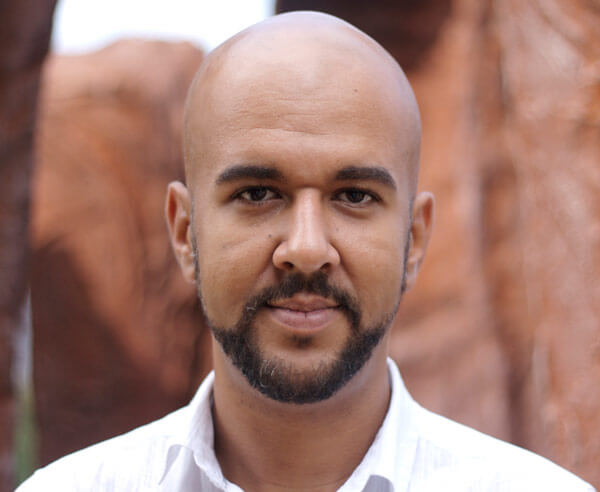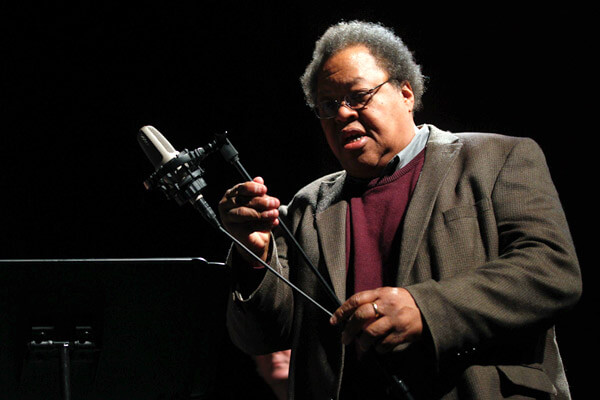Friday, October 18
Highlights from the third day of the festival included Kurt Isaacson’s color boundaries and plastic action/red ground behind my eyelids for piccolo and soprano saxophone. Elise Roy and Matthew Younglove, for whom it was written, alternated unforgivably shrill chords with rapid, breathy figurations in a visceral and arresting experience. Alex Mincek’s tightly wound and energetic Nucleus violently alternated between contrasting rhythmic textures. The extended timbral range of Noa Even’s tenor saxophone allowed her to blend with the sensitive varieties of attacks in Stephen Klunk’s drum set, creating the effect of a hybrid solo instrument more than a duo.
Ensemble Dal Niente gave a full concert Friday evening, demonstrating the breadth and refinement of their repertoire. Rebecca Saunders’ Stirrings Still II opened the concert. Sparse and ethereal melodic fragments drifted from the players spread around cavernous Kobacker Hall, complementing Mark Buchner’s resonant bass on a blue-lit stage. The occasional ringing of bowed crotales, completely hidden from view, was a charming surprise. George Lewis’ raucous Assemblages received its world premiere by the entire ensemble, full of special effects and barely-controlled chaos. Dal Niente also premiered BGSU professor of composition Mikel Kuehn’s Undercurrents, a contrapuntally detailed yet spacious work that faded to a quiet conclusion, resonating throughout the hall.
The concert ended with Salz, by Enno Poppe, a 15-minute crescendo bolstered by Winston Choi on organ sampler. In particular, violist Doyle Armbrust’s snaking, delicate lines that began the piece and percussionist Gregory Beyer’s intricate and powerful rhythms that ended it anchored Dal Niente’s exuberant virtuosity.
Saturday, October 19
Saturday began with a concert of music by the winners of the BGSU Young Composers Competition and composition students from the Toledo School of Arts. All of the promising young composers were in attendance and gave short program notes from the stage.

Composer Marcos Balter (photo credit: Kat Keers)
Saturday’s penultimate concert was entirely electroacoustic, with live performers aided by a variety of electronic media. Marcos Balter’s Cardinal for baritone saxophone received its world premiere. Aided by a healthy dose of delay and reverb, Dal Niente saxophonist Ryan Muncy let forth a stream of constantly clicking keys, with ghostly pitches emerging from a turbulent veil of air. Jeff Manchur performed Timothy Roy’s Wunderkind for toy piano and live electronics with sensitivity and power despite the diminutive size of the instrument. Carter John Rice’s Building Fractures employed samples of breaking objects, including glass and celery stalks, while mezzo-soprano Elizabeth Pearse sang a similarly disjointed text about the nature of fracturing. Pianist Stephanie Titus and flutist Elise Roy aided her splendidly. Matthew McBride-Daline played John Drumheller’s “The View From Dead Horse Point.” for viola and electronics. After a thick layer of effects brought the somber piece to a climax, it closed with a very simple melodic line and long delay that created a plaintive canon.
The BGSU Wind Ensemble and Philharmonia performed the final concert of the festival on Saturday evening. The first half’s highlight was The Shadow of Sirius by Joel Puckett, with Conor Nelson as flute soloist. Rich, low chords from the ensemble supported Nelson’s lyrical playing, and the Wind Ensemble’s flute section interjected occasionally with floating melodic cells from around the hall. The second half featured, among works by Cindy McTee and Shen Yiwen, the world premiere of Braxton Blake’s clarinet concerto Aria and Toccata, performed by Kevin Schempf with clear phrasing and virtuosity.
It’s not too soon to be planning to attend next year’s Bowling Green New Music Festival when the featured artists will be composer Paul Dresher and the Pul Dresher Ensemble.





















